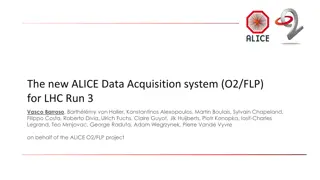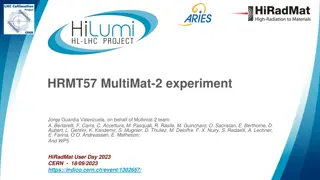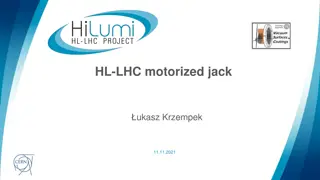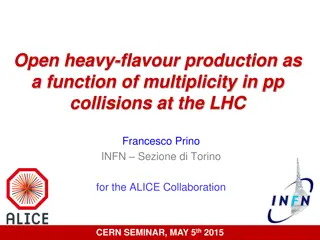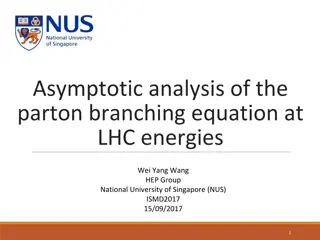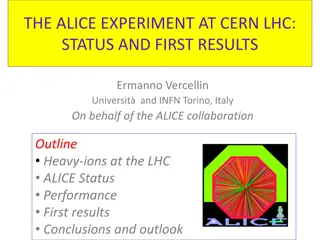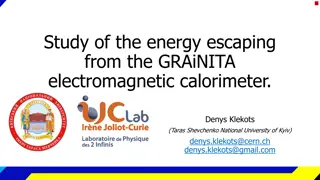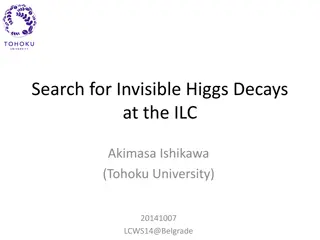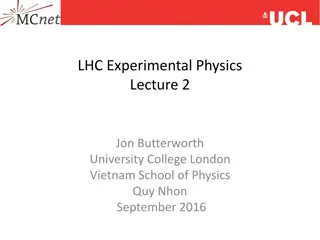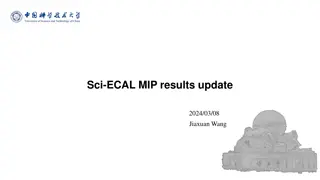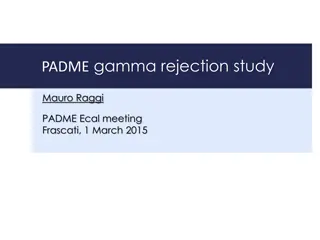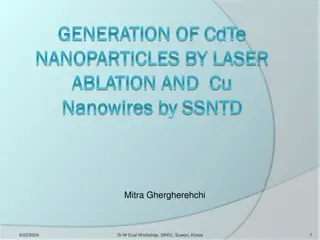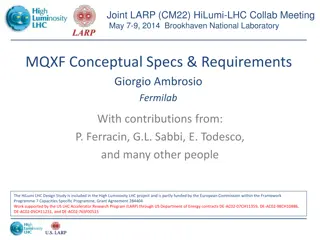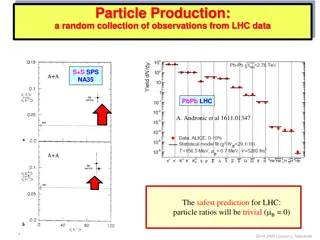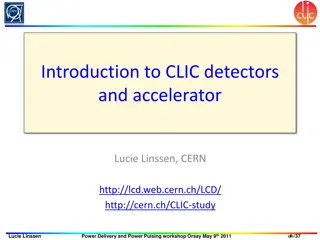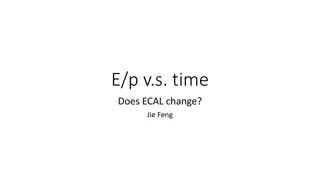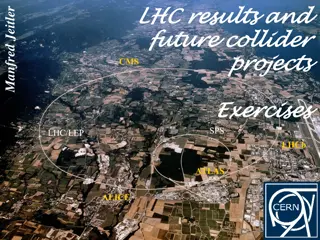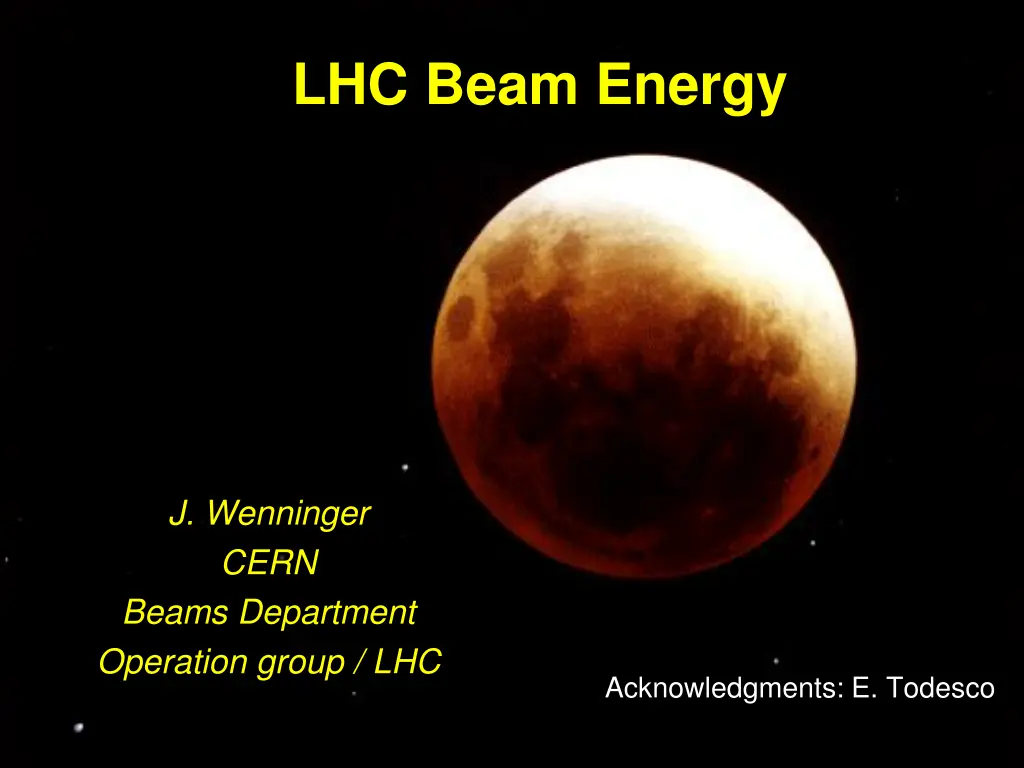
Understanding Beam Energy and Momentum in Large Hadron Collider (LHC)
Explore the concepts of beam energy, momentum, and magnetic fields in the Large Hadron Collider (LHC). Learn about the integral contributions of different magnets, the role of quadrupoles in focusing beams, and the effects of changes in circumference and orbit length on the LHC operation. Discover how external forces impact the beam trajectory and energy levels within the accelerator.
Download Presentation

Please find below an Image/Link to download the presentation.
The content on the website is provided AS IS for your information and personal use only. It may not be sold, licensed, or shared on other websites without obtaining consent from the author. If you encounter any issues during the download, it is possible that the publisher has removed the file from their server.
You are allowed to download the files provided on this website for personal or commercial use, subject to the condition that they are used lawfully. All files are the property of their respective owners.
The content on the website is provided AS IS for your information and personal use only. It may not be sold, licensed, or shared on other websites without obtaining consent from the author.
E N D
Presentation Transcript
LHC Beam Energy J. Wenninger CERN Beams Department Operation group / LHC Acknowledgments: E. Todesco 1
Outline Beam energy LHC Beam Energy / Top WS 17.05.2016 2
Beam momentum - definitions The deflection angle d of a particle with charge Ze and momentum P in a magnetic field B(s): ds ( ) ds ( Ze B s ds = = d ) s P Integrated over the circumference: Ze d C C = 2 = ( ) d B s ds LHC Beam Energy / Top WS P The momentum is given by the integrated magnet field: Ze 2 C C = = ( ) 47 [ 7 . MeV/(cTm) ] ( ) P B s ds Z B s ds = 0 . 7 TeV/c P LHC: 1232 14.3m long dipoles, 8.33 T 17.05.2016 3
Beam momentum Which magnetic fields / magnets contribute to the integral? In the ideal LHC only the dipoles contribute. In the real LHC the contributions to the integral (typical values) are: Dipoles 99.9% Quadrupoles few 0.01% Dipole correctors ~ 0.01% Higher multipoles < 0.01% LHC Beam Energy / Top WS For target accuracies at the level of ~0.1%, only the dipoles and quadrupoles matter the rest can be lumped into the systematic error. 17.05.2016 4
Circumference and orbit length The speed c (and momentum P), RF frequency fRF and length of the orbit L are coupled: frev= Hz 11'254 L L f = f h f = = = RF c L f RF rev rev T h rev The RF frequency is an integer multiple of the revolution period, In the ideal case, the orbit length L matches the circumference C as defined by the magnets, L=C, fRF is matched, the beam is on the design orbit. LHC Beam Energy / Top WS h = 35 640 What happens if an external force changes the circumference of the ring, or if fRF is not correctly set, such that L C ? L = C L > C 17.05.2016 5
Quadrupoles and circumference The role quadrupoles in the LHC is to focus the beams. When L=C (on central orbit ) there is no bending by the quadrupoles. No effect on the energy. If L C, the beam is pushed off-axis through quads, giving a net bending in each quad. The energy change can be expressed by: 1 E L C L C = 3100 E C C LHC Beam Energy / Top WS c Strong amplification (for large accelerators) c = momentum compaction factor 17.05.2016 6
LEP classic: Earth tides Tide bulge of a celestial body of mass M at a distance d : M ) 1 2 3 ( cos R 3 2 d = angle(vertical, celestial body) LHC Beam Energy / Top WS Earth tides : Predicted circumference change The Moon contributes 2/3, the Sun 1/3. NO 12 hour symmetry (direction of Earth rotation axis). Not resonance-driven (unlike Sea tides !). Reasonably accurate predictions available. 17.05.2016 @ LHC E/E ~ 1.2 10-4 7
Circumference evolution To provide energy predictions for every LEP fill, the long-term evolution of the LEP circumference had to be monitored (also done for LHC). Mainly by observing the beam with beam position monitors (BPMs). The LEP/LHC tunnel circumference is subject to seasonal (and reproducible) changes of 2-3 mm. E/E ~ 2-3 10-4 LHC 2012 LHC Beam Energy / Top WS LHC 2015 17.05.2016 8
Energy stability Both tidal effects and the slow circumference changes are automatically compensated by the LHC orbit feedback. Net impact of circumferences changes < 0.01% Impact of dipole orbit correctors is 0.02%. The current stability of the 8 dipole power converters is ~few part per million. The stability of the current calibration (repeated ~ TS) is at a similar level. Impact of the PC is << 0.01% Super-conducting magnets do not suffer from temperature effects like room temperature magnets. LHC Beam Energy / Top WS Beam data confirms field stability << 0.01% For energy uncertainties on the scale of ~0.1% only the absolute calibration is important, one can neglect time dependent effects (unlike LEP !). It is safe to assume that the energy is stable over a run to 0.02%. 17.05.2016 9
Outline Magnetic model and field calibration LHC Beam Energy / Top WS 17.05.2016 10
Magnetic model The energy information on LHC page1, which coincides (rather well) with the energy that is set in the LHC magnets by the control system, is obtained from the magnetic model of the LHC dipoles. The transfer function (TF, or calibration curve) between PC currents (at LHC 8 independent PCs) and magnetic field was established during the magnet testing at SM18 and in the firms. LHC Beam Energy / Top WS The TF is established from: Around 240 dipoles that were measured at 1.9 K across the entire field & current range (few 100 A to 12 000 A), o All 1232 dipoles measured at room temperature at a current of 8.5 and/or 10 A. o 17.05.2016 11
Magnetic model cold-warm The TF is build using data from the 1.9 K data to define the full shape along the cycle. This includes the geometric TF (~ what you expected from an ideal magnet) and various error components like saturation of the iron, magnetisation of the cable etc. The geometric component is based on the 1.9K measurements for the magnets measured in SM18 . For the other magnets it is based on the RT measurement corrected for the warm-cold correlation of the magnets measured at 1.9K in the form of an offset of 8x10-6 Tm/A. LHC Beam Energy / Top WS Correlation 1.9K room T <geometric TF> (1.9K) = 0.010117 Tm/A Magnet-2-magnet spread ~0.06% 17.05.2016 12
Dipole transfer function The energy versus current TF (2016 ramp settings) for one of the 8 sectors (extracted from the LHC controls DB). LHC Beam Energy / Top WS Deviation from the straight line (slope at 5 kA) of the TF. The saturation at high current is significant for energy calibration. At 6.5 TeV the deviation is ~0.4% (0.6% at 7 TeV). Iron saturation 17.05.2016 13
Dipole transfer function The final dipole transfer function deviates from a straight line by -0.6% due to iron saturation at high field (> 5 TeV). The systematic error on the TF is estimated to ~ 0.1%. The energy difference between ring1 and ring2 is estimated to < 0.01%. LHC Beam Energy / Top WS 17.05.2016 14
Outline Beam energy measurements at LHC LHC Beam Energy / Top WS 17.05.2016 15
Proton-ion calibration principle (1) At the LHC there is currently only one method to determine the energy with the beam with an interesting accuracy based on the comparison of the revolution frequency of protons and ions. To confirm independently the magnetic model numbers o The speed (and momentum P), RF frequency fRF and circumference C are related to each other: f C f C c = rev= RF 2 unknowns (C & /P) h LHC Beam Energy / Top WS The speed p of the proton beam is related to P: An ion of charge Z circulating in the same ring, on the same orbit, has a momentum ZP and a speed i given by: Provides a 2nd measurement to extract the 2 unknowns (C & /P) 17.05.2016 16
Proton-ion calibration principle (2) The 2 equations for p and i can be solved for the proton momentum P: for Pb82+ 2.5 LHC Beam Energy / Top WS Momentum calibration principle: Inject protons into the LHC, center the orbit such that L=C. Measure the RF frequency. Repeat for Pb ions. The frequency difference f gives directly the energy. This is the method that is used at the LHC 17.05.2016 17
Scaling with energy When ions become very relativistic, the difference wrt protons decreases, The frequency difference scales 1/P2: Proton Lead ~4.5 kHz LHC Beam Energy / Top WS ~60 Hz ~20 Hz Target errors to reach 0.1% uncertainty on the energy. LHC Error on radius difference between p-Pb R ~ 1 m ! The LHC beam position monitor system works rather well down to 20 m, but one micron accuracy is a challenge (wrt systematic errors). 17.05.2016 18
Proton-Lead Before the p-Pb run in 2013, proton and Lead ions were never present at the same time in the ring. For an accurate energy measurement all effects that could modify the ring circumference had to be controlled at the m level no chance to get an accurate measurement at high energy. Accurate measurements at injection were possible. With p-Pb the situation became more favorable. Since we only have to know the relative radial position of p and Pb, tides and other geological effects do not bias the measurement. But it remains a delicate measurement - two rings ! LHC Beam Energy / Top WS The p-Pb run in 2013 was used to measure the energy parasitically to the physics run. Every fill provided a measurement. 17.05.2016 19
Proton-Lead cycle Injection: the RF frequency difference is large (~4.6 kHz). Each beam runs at the frequency that maintains it centered in the magnets. The RF systems of the 2 rings are unlocked. Flat top: the two beams are forced on a common frequency and re-phased to collide at the IPs. The RF systems are locked. LHC Beam Energy / Top WS 17.05.2016 20
Orbit shifts at flat top After the RF manipulations on flat top, both beams are forced to run at the same RF frequency The protons move outwards, Pb inwards due to the speed difference ! The frequency difference is extracted from the beam position data. Orbit shifts induced by forcing the same RF frequency Protons B1 LHC Beam Energy / Top WS Lead B2 1.6 (mm) x 17.05.2016 LHC circumference 21
Systematic BPM errors The frequency offset are be biased by offsets of the BPMs. Mechanics (~0.1 mm alignment wrt quadrupoles) & electronics. Offsets ( f1 , f2) can be different for ring 1 and ring 2. p-Pb Pb-p x LHC Beam Energy / Top WS f1 f2 R2 R1 R2 R1 fpPb = f + ( f1 + f2) fPbp = f - ( f1 + f2) 2 f = fpPb + fPbp Averaging results for p-Pb ( fpPb) and Pb-p ( fPbp) configurations cancels the static offsets ! 17.05.2016 22
Frequency to energy Changing the selection of BPMs and the quality cuts has little influence on the results. From the most reliable set of fills (around the BPM scale calibrations): All fills (after cuts) Systematic error: selection cuts, intensity dependence, scale error. LHC Beam Energy / Top WS 10 fills / period (around BPM cal.) Resulting energy and error: Deviation wrt magnetic model (4 TeV): -0.35 0.52% 17.05.2016 23
Energy at injection Frequency difference at injection, assuming a conservative 2 Hz error: 10 fills / period (around BPM cal.) o Very precise measurement (as expected). LHC Beam Energy / Top WS o Deviation wrt magnetic model: 450GeV +0.06 0.03% Independent verification of the TF at injection. The deviation is consistent with the estimated accuracy of the magnetic measurements. 17.05.2016 24
Energy measurement summary The energy measurements are consistent with the magnetic model within the estimated uncertainties. At injection the agreement is at 0.1% level within the estimated errors. o At 4 TeV the 0.5% uncertainty of the beam measurement is dominated by the systematic errors result is in agreement with magnetic model. o At the end of the 2016 run, the coming p-Pb run provides an opportunity to re-measure at 6.5 TeV. Requires inversion of the beams (or a dedicated measurement). o LHC Beam Energy / Top WS With the increased BPM accuracy after LS1, there is good hope to obtain a similar relative uncertainty despite the higher energy (and smaller signal). o Independent estimates based on the corrections applied to for optics, tune etc at high energy are consistent with an energy uncertainty of ~0.1%. Not real energy measurements ! o 17.05.2016 25
Status and next step Independent energy measurements at the LHC are currently unlikely to achieve uncertainties below 0.5% at high energy. The magnetic model of the LHC is estimated (for the dipole field) to be accurate to ~0.1%. All beam energy measurements confirm the energy predicted from the magnetic model, to 0.1% at injection ! Time dependent effects are negligible on the 0.1% scale. LHC Beam Energy / Top WS The goal for the (very) near future is to re-evaluate all errors and provide an official uncertainty based for example on the direct energy measurement at injection combined with magnetic model interpolation. The error is expected to be at the level of 0.1%. 17.05.2016 26

